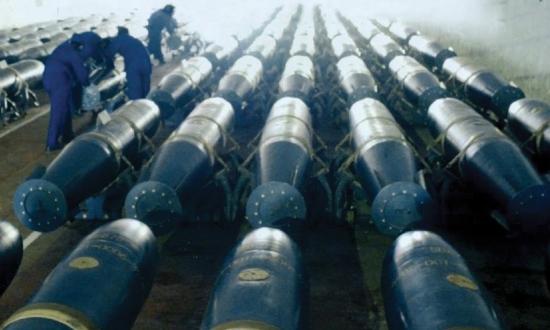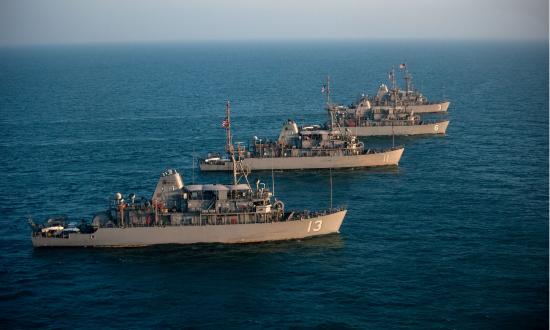Ukrainian resistance cells are demonstrating the value irregular warfare operations can have even in modern high-intensity conflict. Stories of heroic guerrilla actions are coming to light as Vladimir Putin’s forces have withdrawn from occupied territories. Watermen, pensioners, and even a wealthy couple on a yacht stranded by the war served a vital function in liberating the port city of Kherson on the Black Sea Coast. In a future conflict, allied resistance cells could be used to emplace mines to blunt enemy amphibious operations, limit logistical resupply, and target enemy commerce.
Arithmetic on the Frontier
Insurgents count on Rudyard Kipling’s “Arithmetic on the Frontier”—“Two thousand pounds of education // Drops to a ten-rupee jezail”—to establish a loss exchange ratio that the aggressor find unsustainable. The sinking of Russia’s flagship Moskva was not only the loss of a $750 million warship and much of her crew, but also a blow to Moscow’s morale and prestige. The two Neptune missiles that sunk her cost orders of magnitude less than the cruiser. In 1988, the USS Samuel B. Roberts (FFG-58) struck an Iranian mine and suffered catastrophic damage, with repair costs exceeding $90 million. Three years later, the USS Tripoli (LPH-10) and Princeton (CG-59) were severely damaged on the same day during the Gulf War. The Tripoli lay dead in the water for hours, a hole blasted in her hull by a $500 contact mine.
The war in Ukraine demonstrates that the application of modern technology by resolute defenders can lead to drawn-out attritional warfare. Naval mines can not only deny an enemy access and discourage amphibious operations, but also support resistance strategies such as the “indigestible hedgehog”—in which frontline hedgehog states demonstrate their own defensive capabilities as “part of an active information campaign and as a policy tool,” demonstrating that the prospective costs of occupation outweigh any gains an aggressor might hope to achieve. This model could have utility for the Baltics, Scandinavia, and Taiwan, for example. Mines could play an offensive role in a strategy focused on maritime trade warfare in the event of conflict with China. China is dependent on overseas shipborne transport for energy, food, and critical minerals, and these supplies could be threatened by naval mines.
The U.S. Navy and Marine Corps should prepare for the use of mines in great power conflict. First, they should develop plans to assist allied countries develop resistance cells and irregular forces in employing mines, as part of the larger Resistance Operating Concept developed by U.S. Special Operations Command. Second, the Sea Services should invest in infrastructure and equipment which could be forward deployed, to allow fabricating of mines in wartime through additive manufacturing. Finally, the U.S. should develop doctrine for the offensive use of mines by allied forces in irregular warfare; and as a tool to conduct Maritime Trade Warfare to deny adversaries access to critical overseas resources in a global great power conflict.
Resistance Planning
U.S. special operations forces are at the vanguard of helping partner nations develop irregular warfare capabilities as set out in the Resistance Operating Concept (ROC). Some of the partisan units now fighting in Ukraine organized spontaneously, but others were set up by Ukrainian special forces or intelligence services subsequent to the 2014 Russian invasion of Crimea—in part based on training provided by U.S. forces. Undoubtedly, Naval Special Warfare and Marine Special Operations Command units will be part of the effort. However, conventional Marines and sailors can play a role in developing partner capabilities by providing equipment and training on the employment of naval mines.
Improvised explosive devices were the default tool of the Taliban, Iraqi Shi’a militia, and the Islamic State fighting forces. Two of these insurgencies benefited from state sponsorship: The Taliban were aided by the military/intelligence services of Iran, Pakistan, Russia, and China; and Iraqi militants remain funded and advised by the Iranian Islamic Revolutionary Guard Corps—Qods Force (IRGC-QF). The IRGC-QF provided particularly lethal assistance to anti-coalition forces using explosively formed penetrators, which they continue to stockpile for use by Shi’a insurgent cells in Bahrain and Saudi Arabia. Turnabout is fair play, and naval mines could be used by resistance forces in the littorals against Chinese, Russian, Iranian, or other hostile actors.
A notable historic example of a sea-based insurgent element of a larger resistance organization is the Sea Tigers—the maritime arm of the Liberation Tigers of Tamil Eelam, which fought for an independent Tamil state in Sri Lanka from 1976 to 2009. The Sea Tigers invested significant effort in developing attack capabilities and munitions—including mines constructed from household goods—to deploy against government forces. Nation-states can also adopt a naval insurgency approach. For example, some scholars recommend that South Korea focus on “sea insurgency” both offensively and defensively to counter potential North Korean asymmetric naval warfare.
The United States needs to plan for supporting resistance efforts ranging from assisting Taiwan in countering a Chinese invasion to aiding the Baltic States in a future conflict with Russia or multiple allied countries in a broader Pacific conflict. Mines emplaced by local resistance elements could help blunt enemy amphibious landings, and choke seaborne supply-lines supporting an enemy offensive. Naval mines should play a role in these efforts.
Additive Manufacturing
One criticism of the ROC is that it does not take into account the need for “purpose-built equipment and weapons.” Modern insurgents need weapons that can easily be produced near the front, as resupply in high-intensity conflict may become extremely challenging. The United States could preposition mines, but this would require significant warehouse space with attendant security and hardened facilities, and these could become known sites for the enemy to target.
Additive manufacturing presents an alternative. The democratization of this type of equipment has changed it from a tool for large industry to an affordable system for consumers. Additive manufacturing could provide a production capability and allow for a smaller footprint in the event that war becomes inevitable or once underway. Logistics are likely to be contested in any great power conflict, and new methods such as pre-staged, covert “sleeper cell logistics” could become common. The U.S. Army has already developed a mobile expeditionary production system that fits five 3D printers in a small trailer. Mines are not particularly complex and could be constructed by relying largely on 3D printing. While it is not yet possible to 3D print explosives, research is ongoing. Storing explosive cores would require less room than entire mines. American-provided explosive materials could be cached. In addition, allies might issue military-grade explosives, or guerrillas could fabricate them locally.
U.S. forces need not be the ones producing naval mines in theater. The continued proliferation of 3D printing may allow civilian resistance groups to fabricate their own. Ukrainians using 3D printers have already manufactured parts that allow them to drop explosives on Russian forces from commercial drones; plans circulate online for home-made “ghost guns” such as the FGC-9 using 3D fabrication; and retired U.S. Army Major John Spencer published the widely disseminated “Mini Manual for the Urban Defender” as a primer for civilians after Putin’s invasion. Similarly, U.S. forces could consider judicious sharing of design files for the fabrication of mines electronically at the outset of a future conflict.
Finally, additive manufacturing may be a particularly useful method for constructing naval mines, as non-metallic mines have become increasingly common. It was two Italian-made Manta mines (a nonmetallic mine made with a glass-reinforced plastic case) that crippled the Princeton in 1991. Iran is also currently producing “nonmagnetic, free floating, and remote-controlled mines.”
Offensive Mining for Maritime Trade Warfare
In a protracted global conflict, the United States may have to pursue a strategy of exhausting its enemy and reducing its ability to continue to wage war. Economic warfare would therefore likely become an important means of war. World War II is instructive in this regard. As part of the war in the Pacific, the Navy pursued a maritime trade warfare campaign, starving the Japanese war machine at home and choking off supplies to many of its Pacific outposts. All major combatants in World War II used naval mines to restrict access to sea as well as blockade seaports. Mines accounted for the sinking of 650 Allied vessels and 1,100 Axis ships, while damaging hundreds more—sinking or damaging more shipping than any other weapon.
China is highly dependent on the importation of natural resources—it is now the world’s largest importer of oil and gas—frequently transported by unarmed merchant ships from Africa, Latin America, and the Persian Gulf. Rand Corporation analysts predict that a war between the United States and China would be lengthy, and China’s dependence on overseas trade, especially energy resources, would represent a center of gravity. Military strategist and retired Marine Colonel T. X. Hammes writes that great power conflicts over the past 200 years have lasted years rather than months. As a result, he has proposed a strategy of “Offshore Control” to strangle Chinese exports as well as interdicting its imports to lead to economic exhaustion, allowing the communist leadership to end the conflict while saving face by being able to state that they did not lose militarily.
The U.S. Sea Services could rely on foreign proxies (or even auxiliary troops) as force multipliers, using mines offensively against the adversary’s commerce. Resistance forces in a global conflict could strike wherever and whenever they had capabilities. Not only could resistance units blockade harbors, but in some cases, they also could sabotage specific enemy vessels, port facilities, and infrastructure.
The Tamil Sea Tigers carried out such an approach in their long-running independence struggle. Sea Tiger engineers designed and built mines that were employed against government naval vessels and that damaged Sri Lankan maritime commerce. Similarly, in a little remembered incident during the Vietnam War in May 1964, Viet Cong saboteurs attached explosives to the USNS Card (CVE-11) as she lay anchored in Saigon harbor. In an early morning attack, the bombs detonated and sank the escort carrier—the last U.S. carrier lost to enemy action.
Legal Framework
The use of mines by resistance forces is lawful. It is generally accepted that naval warfare is governed by the 1907 Hague Conventions and the 1995 San Remo Manual on International Law Applicable to Armed Conflicts at Sea—which allow the use of naval mines subject to certain restrictions. Allied military forces conducting resistance operations would be subject to this legal framework. There is extensive debate regarding whether irregular forces are lawful combatants, though noted maritime scholar and mine warfare expert Scott Truver suggests that mining by nonstate actors during armed conflict is permissible.
U.S. Navy lawyers should clarify aspects of the recently revised The Commander’s Handbook on the Law of Naval Operations (NWP 1-14M), which states that mines cannot be set solely to intercept commercial shipping, but that they can be used for strategic blockade. NWP 1-14M also allows the targeting of enemy commercial shipping if engaged in a “war sustaining or war supporting role.”
For offensive and defensive lawfare purposes, JAGs should develop guidance for U.S. forces advising and supporting irregular forces in employing naval mines.
Looking Forward
The war in Ukraine and the U.S. experience in Iraq and Afghanistan have shown the impact a motivated and resourceful resistance can have against a modern occupier—particularly if supported by an outside power. Naval mines and mine warfare have application in resistance operations, and U.S. naval forces should develop a strategy for their employment by resistance elements fighting near-peer adversaries such as Russia or China. Furthermore, additive manufacturing may allow indigenous forces to potentially manufacture naval mines in occupied territories to use against aggressors. Moreover, the use of naval mines by resistance elements should be considered as a means to engage in maritime trade warfare on a global scale, particularly against Chinese commercial maritime assets to degrade the communist state’s ability to compete against the U.S. and its allies in a long-running major war. Finally, U.S. naval lawyers should clarify any unresolved issues regarding the conduct of mine warfare by irregular forces. Naval mines are some of the oldest weapons still in use, but with modern technology and doctrine, they have continued relevance and utility for irregular forces in great power conflict.






